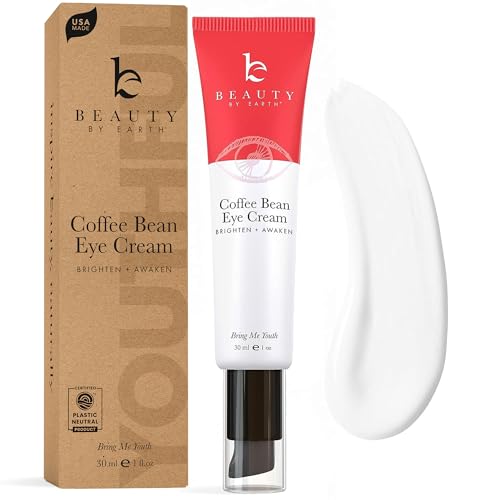
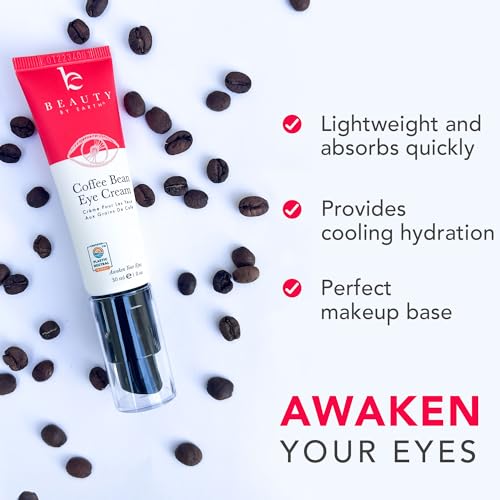
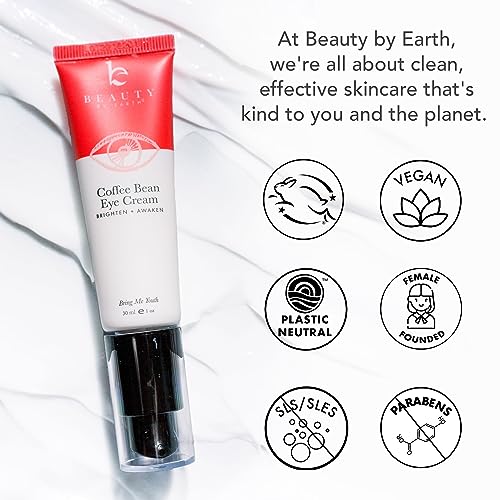
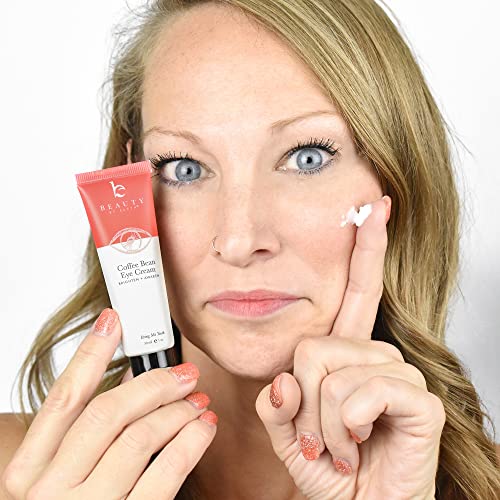
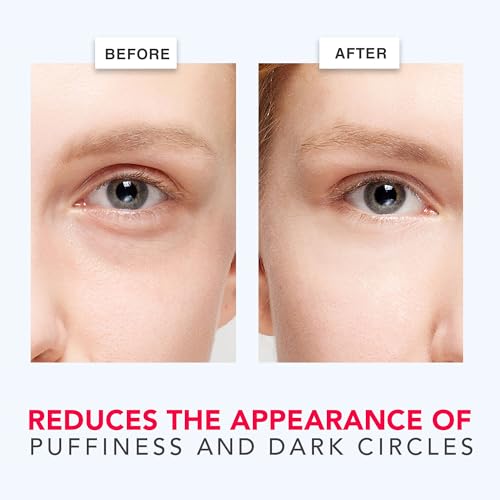
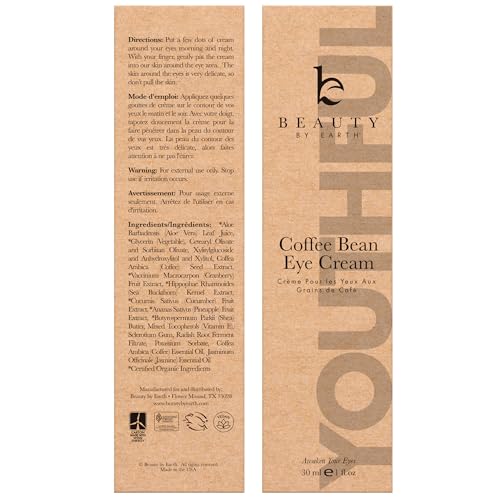
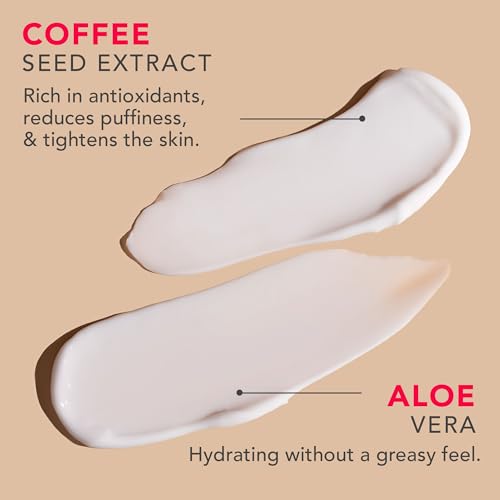
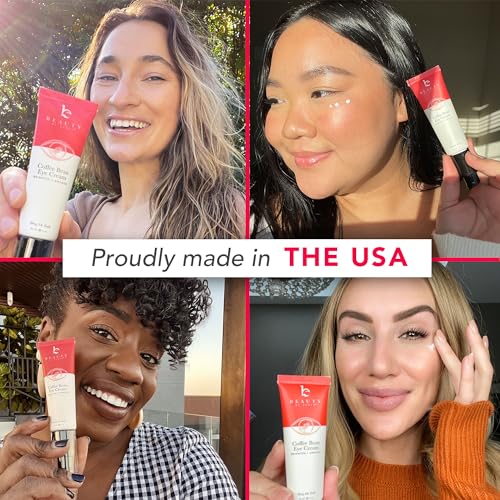
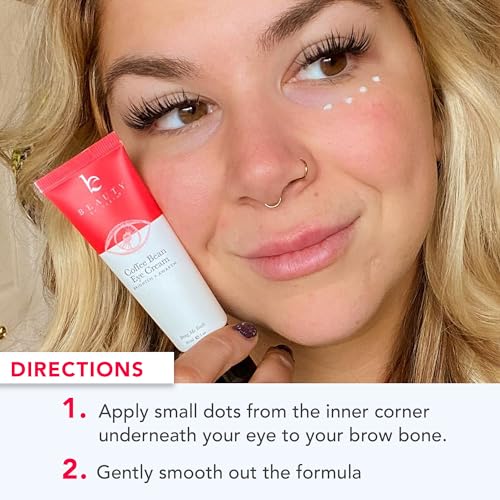
Caffeine Eye Cream - Reduces Dark Circles & Puffiness, Hydrating with Glycerin & Vitamin E - 0.5oz


Jasminum Officinale (Jasmine) Oil
High RiskJasminum officinale (jasmine) oil is a volatile essential oil derived from the flowers of the jasmine plant. It is commonly used in cosmetics and personal care products for its fragrance and potential therapeutic properties.
Sustai Insights
Jasmine oil offers functional benefits such as providing a pleasant fragrance and potential skin-soothing properties. However, it has a high allergenic potential, posing risks of allergic reactions in sensitive individuals. While its carcinogenicity and developmental toxicity are low, regulatory bodies have placed some restrictions on its use due to these concerns. Overall, the risk level associated with jasmine oil is high, particularly in formulations where skin contact is frequent. Safe usage practices should be observed, and alternatives like synthetic fragrances could be considered.
Glycerin
Medium RiskGlycerin (also called glycerol) is a naturally occurring compound commonly used in personal care and cosmetic products. It functions as a humectant, attracting moisture to the skin, and is also utilized as a solvent and emollient to enhance product texture and stability.
Sustai Insights
Glycerin is valued for its effective moisturizing properties and biodegradability, making it a widely accepted ingredient in formulations. It poses low health risks, including low concerns for carcinogenicity and allergies. However, moderate use restrictions exist due to regulatory guidelines. While glycerin does not significantly contribute to environmental pollution, its production process should be ethically sourced. Overall, glycerin holds a medium risk level, emphasizing the importance of safe usage practices and considering sustainable alternatives.
Potassium Sorbate
Medium RiskPotassium sorbate is a potassium salt of sorbic acid, primarily used as a preservative in food and cosmetic products. It inhibits the growth of molds, yeast, and some bacteria, extending the shelf life of products. It is commonly found in various formulations due to its effectiveness and low toxicity.
Sustai Insights
Potassium sorbate serves as an effective preservative, preventing microbial growth in food and cosmetic products, which is vital for safety and longevity. Although it has a low risk of carcinogenicity and developmental toxicity, there is a moderate concern regarding allergies and immunotoxicity. Environmentally, it poses minimal risks as it is not significantly bioaccumulative. Regulatory agencies have verified its use, although some products may face restrictions. Overall, it is assessed as a medium risk ingredient, with safe usage practices recommended, and alternatives such as natural preservatives could be considered.
Xylitol
Low RiskXylitol is a sugar alcohol used primarily as a sweetener. It is commonly found in oral care products and food items, offering a sweetening effect similar to sugar but with fewer calories. It serves as a humectant and can contribute to dental health by reducing the risk of cavities.
Sustai Insights
Xylitol provides functional benefits as a low-calorie sweetener and may help improve dental health by inhibiting cavity-causing bacteria. It is generally recognized as safe by the FDA with low concern for cancer, allergies, or reproductive toxicity. Environmental risks are minimal, as xylitol is biodegradable and does not accumulate in the ecosystem. Regulatory bodies have not imposed significant restrictions. Overall, xylitol presents a low risk when used appropriately, with no major adverse health effects reported and sustainable sourcing options available.
Cetearyl Olivate
Low RiskCetearyl olivate is composed of cetearyl alcohol and the fatty acids derived from olive oil. It is primarily used as an emulsifier and skin-conditioning agent in cosmetic formulations, helping to stabilize and enhance the texture of creams and lotions.
Sustai Insights
Cetearyl olivate serves as an effective emulsifier, contributing to product stability and texture. It is derived from olive oil, making it a sustainable choice due to its biodegradable nature. Health concerns are low, with minimal risks for irritation and allergies. Regulatory status is favorable, with no significant warnings. Environmental risks are also low, indicating it does not pose substantial hazards. Overall, the ingredient presents a low risk profile, making it a safe option in cosmetic products.
Cucumis Sativus (Cucumber) Fruit Extract
Low RiskCucumis sativus (cucumber) fruit extract is derived from the fruit of the cucumber plant. It is commonly used in cosmetic formulations for its hydrating and soothing properties, often included in products aimed at providing moisture and calming effects to the skin.
Sustai Insights
Cucumis sativus fruit extract offers functional benefits such as hydration and soothing effects on the skin, contributing to the overall efficacy of cosmetic products. It is regarded as low risk with minimal health concerns, including low potential for carcinogenicity, irritation, or allergies. Environmental risks are also low, with no significant pollutant or bioaccumulation concerns. Regulatory bodies do not impose restrictions on its use, supporting its safety in cosmetics. Safe usage practices include ensuring proper formulation concentrations. Overall, this ingredient presents a low risk profile, making it a suitable choice for various cosmetic applications.
Coffea Arabica (Arabian Coffee) Seed Oil
Low RiskCoffea arabica (coffee) seed oil is an oil obtained from the seeds of the Coffea arabica plant. It is commonly used in cosmetic formulations for its moisturizing properties and is often included in products for its potential benefits to skin health.
Sustai Insights
Coffea arabica seed oil offers functional benefits as a moisturizer and may contribute to skin nourishment. It is sustainably sourced and poses low health risks, with minimal concerns regarding carcinogenicity, allergies, or reproductive toxicity. Environmental assessments indicate low pollutant potential and bioaccumulation. Regulatory bodies have not placed restrictions on its use, supporting a low overall risk level. Safe usage practices include proper formulation concentrations. Alternatives like jojoba oil can provide similar benefits with potentially enhanced sustainability.
Vaccinium Macrocarpon (Cranberry) Fruit Extract
Low RiskVaccinium macrocarpon (cranberry) fruit extract is derived from the fruit of the cranberry plant. It is commonly used in cosmetic and personal care products for its antioxidant properties and ability to provide moisture and nourishment to the skin.
Sustai Insights
Cranberry fruit extract offers functional benefits such as antioxidant protection and skin hydration, contributing positively to product efficacy. It is sustainably sourced and generally recognized as safe, presenting low health risks, including minimal concerns for carcinogenicity and irritation. Environmental impacts are low, with no significant pollutant or bioaccumulation concerns. Regulatory assessments indicate no restrictions. Overall, cranberry fruit extract is considered low risk, and safe usage practices involve normal cosmetic applications. Alternatives include other fruit extracts with similar benefits.
Sclerotium Gum
Low RiskSclerotium gum is a polysaccharide gum produced by the fermentation of certain fungi. It serves primarily as a thickening, stabilizing, and gelling agent in various cosmetic formulations, contributing to texture and consistency.
Sustai Insights
Sclerotium gum offers functional benefits as a stabilizer and thickener in cosmetic products. It is considered low risk for health concerns, including carcinogenicity, allergies, and reproductive toxicity. Environmentally, it poses minimal risks and is not known to bioaccumulate. Regulatory agencies have not issued significant warnings, affirming its safety for use. Overall, the risk level associated with sclerotium gum is low, making it a viable ingredient in formulations, with no pressing need for alternatives.
Ananas Sativus (Pineapple) Fruit Extract
Low RiskAnanas sativus (pineapple) fruit extract is derived from the pineapple fruit and is commonly used in cosmetic and personal care products for its potential skin benefits, including hydration and exfoliation. It contains enzymes and vitamins that contribute to its function in formulations.
Sustai Insights
Ananas sativus extract offers functional benefits such as hydration and exfoliation due to its enzyme content. It is generally regarded as safe, with low associated health risks, including carcinogenicity, allergenic potential, and reproductive toxicity. Environmentally, it poses minimal risks, being biodegradable and sourced sustainably. Regulatory status is favorable, with no current restrictions noted. Overall, the risk level is assessed as low. For enhanced sustainability, alternatives such as plant-based enzymes may be considered.
Sorbitan Olivate
Low RiskSorbitan olivate is a surfactant derived from olive oil and sorbitol. It functions primarily as an emulsifier, allowing for the mixing of oil and water in cosmetic formulations. It is commonly found in creams and lotions, enhancing texture and stability.
Sustai Insights
Sorbitan olivate offers functional benefits as an emulsifier, improving product texture and stability while being derived from a sustainable source. Health risks are low, with no significant concerns regarding carcinogenicity, allergies, or reproductive toxicity. Environmentally, it is not known to bioaccumulate or contribute to pollution. Regulatory bodies have not identified restrictions, indicating a favorable risk level. For safe usage, it is recommended in standard cosmetic formulations, with few alternatives necessary given its low-risk profile.
Anhydroxylitol
Low RiskAnhydroxylitol is a sugar alcohol derived from glucose, commonly used in cosmetic formulations. It primarily functions as a humectant, helping to retain moisture in products, thereby enhancing skin hydration. It is recognized for its role in improving the texture and feel of cosmetic products.
Sustai Insights
Anhydroxylitol offers functional benefits as an effective humectant, contributing to skin hydration and product texture. It is considered low-risk regarding health impacts, with minimal concerns for carcinogenicity, allergies, or reproductive toxicity. Environmentally, it does not pose significant risks, being non-pollutant and non-bioaccumulative. Regulatory assessments indicate no major restrictions, supporting its safe use. Overall, the ingredient is assessed as low risk, making it a suitable choice in cosmetic formulations. Alternatives such as glycerin may provide similar benefits.
Coffea Arabica (Arabian Coffee) Seed Extract
Low RiskCoffea arabica (coffee) seed extract is an extract derived from the seeds of the Coffea arabica plant, commonly used in cosmetic and personal care products for its antioxidant properties and potential skin conditioning benefits.
Sustai Insights
Coffea arabica seed extract provides functional benefits as an antioxidant, potentially improving skin health. It has low associated health risks, including carcinogenicity and allergenic potential, and is not currently restricted by regulatory bodies like the FDA. Environmental impacts are minimal, with no significant pollutant or bioaccumulative concerns. Overall, the ingredient presents a low risk, supporting its safe use in formulations.
Hippophae Rhamnoides (Sea Buckthorn) Extract
Low RiskHippophae rhamnoides extract is derived from the sea buckthorn plant, known for its rich nutrient profile, including vitamins, fatty acids, and antioxidants. It is commonly used in cosmetic and personal care products for its potential skin benefits, such as hydration and nourishment.
Sustai Insights
Hippophae rhamnoides extract offers functional benefits like enhancing skin hydration and providing antioxidant properties. It is sustainably sourced and generally considered low risk for health concerns, including carcinogenicity and allergies. Environmental impacts are minimal, with no evidence of bioaccumulation or pollution. Regulatory bodies have not issued any significant warnings. Overall, the risk level associated with this ingredient is low, making it a suitable choice for various applications.
Leuconostoc/Radish Root Ferment Filtrate
Low RiskLeuconostoc/radish root ferment filtrate is a natural fermentation product derived from radish roots, commonly used in skincare for its potential preservative properties and skin-conditioning benefits. It functions by harnessing the metabolic activity of Leuconostoc bacteria to provide a source of beneficial compounds.
Sustai Insights
This ingredient offers functional benefits, primarily as a preservative and skin-conditioning agent, while being biodegradable and sustainably sourced. Health risks are generally low, with no significant concerns regarding carcinogenicity or allergies, though contamination concerns exist. Environmentally, it poses minimal risks, categorized as low overall risk based on current scientific consensus. Safe usage practices are advised, and alternatives may include other natural preservatives like tocopherol or rosemary extract.
Xylitylglucoside
Low RiskXylitylglucoside is a sugar-based ingredient commonly used in cosmetic formulations for its moisturizing properties. It functions primarily as a humectant, helping to retain moisture in the skin, thereby enhancing the overall texture and hydration of products. It is derived from natural sources and is often included in formulations aimed at improving skin feel.
Sustai Insights
Xylitylglucoside serves as an effective humectant that enhances skin hydration and texture, contributing to product efficacy. It is sustainably sourced and generally regarded as safe, with low concerns regarding cancer, allergies, and toxicity. Regulatory bodies have not placed significant restrictions on its use. Environmental risks appear minimal, with no indications of bioaccumulation or pollution potential. Overall, this ingredient is assessed as low risk, making it a viable choice in cosmetic applications. Safe usage practices should be adhered to, and while alternatives exist, xylitylglucoside is a sound option in many formulations.
Tocopherol
Low RiskTocopherols are a class of naturally occurring compounds, primarily known for their role as antioxidants. They are commonly used in cosmetic and skincare products to help stabilize formulations and protect ingredients from oxidative damage.
Sustai Insights
Tocopherols provide functional benefits such as antioxidant protection and skin conditioning. They are generally recognized as safe, with low concerns regarding carcinogenicity, allergies, and reproductive toxicity. However, enhanced skin absorption and potential endocrine disruption are noted. Regulatory bodies have not imposed significant restrictions on tocopherols, categorizing the overall risk as low. Safe usage practices should be observed, and while alternatives exist, tocopherols remain a viable option in formulations.
Butyrospermum Parkii (Shea) Butter
Low RiskButyrospermum parkii (shea) butter is a vegetable fat derived from the nuts of the shea tree. It is commonly used in cosmetic formulations for its emollient properties, providing moisture and improving skin texture. Additionally, shea butter is known for its ability to enhance the stability of products and deliver a creamy texture.
Sustai Insights
Shea butter offers functional benefits as an effective moisturizer, enhancing skin barrier function and texture. It is sustainably sourced and biodegradable, contributing to eco-friendliness. Health-wise, it is associated with low risks for carcinogenicity, allergies, and reproductive toxicity. Environmental impacts are minimal, with no significant pollutant potential identified. Regulatory assessments indicate no current restrictions. Overall, the ingredient presents a low risk, making it a favorable choice in cosmetic formulations.
Aloe Barbadensis (Aloe Vera) Leaf Juice
Low RiskAloe barbadensis (aloe vera) leaf juice is derived from the succulent aloe vera plant, known for its hydrating and soothing properties. It is commonly used in cosmetic formulations for its moisturizing effects and is often included in products aimed at skin care and healing.
Sustai Insights
Aloe vera leaf juice offers functional benefits as a moisturizer and skin soothing agent, while being sustainably sourced and biodegradable. Health risks are low, with minimal concerns regarding carcinogenicity, allergies, and reproductive toxicity. Environmental impact is also low, with no significant pollutants identified. Regulatory agencies impose few restrictions. Overall, the ingredient poses a low risk, making it a favorable choice in cosmetic formulations.
Xylitol
Low RiskXylitol is a sugar alcohol used primarily as a sweetener. It is commonly found in oral care products and food items, offering a sweetening effect similar to sugar but with fewer calories. It serves as a humectant and can contribute to dental health by reducing the risk of cavities.
Sustai Insights
Xylitol provides functional benefits as a low-calorie sweetener and may help improve dental health by inhibiting cavity-causing bacteria. It is generally recognized as safe by the FDA with low concern for cancer, allergies, or reproductive toxicity. Environmental risks are minimal, as xylitol is biodegradable and does not accumulate in the ecosystem. Regulatory bodies have not imposed significant restrictions. Overall, xylitol presents a low risk when used appropriately, with no major adverse health effects reported and sustainable sourcing options available.
Cetearyl Olivate
Low RiskCetearyl olivate is composed of cetearyl alcohol and the fatty acids derived from olive oil. It is primarily used as an emulsifier and skin-conditioning agent in cosmetic formulations, helping to stabilize and enhance the texture of creams and lotions.
Sustai Insights
Cetearyl olivate serves as an effective emulsifier, contributing to product stability and texture. It is derived from olive oil, making it a sustainable choice due to its biodegradable nature. Health concerns are low, with minimal risks for irritation and allergies. Regulatory status is favorable, with no significant warnings. Environmental risks are also low, indicating it does not pose substantial hazards. Overall, the ingredient presents a low risk profile, making it a safe option in cosmetic products.
Cucumis Sativus (Cucumber) Fruit Extract
Low RiskCucumis sativus (cucumber) fruit extract is derived from the fruit of the cucumber plant. It is commonly used in cosmetic formulations for its hydrating and soothing properties, often included in products aimed at providing moisture and calming effects to the skin.
Sustai Insights
Cucumis sativus fruit extract offers functional benefits such as hydration and soothing effects on the skin, contributing to the overall efficacy of cosmetic products. It is regarded as low risk with minimal health concerns, including low potential for carcinogenicity, irritation, or allergies. Environmental risks are also low, with no significant pollutant or bioaccumulation concerns. Regulatory bodies do not impose restrictions on its use, supporting its safety in cosmetics. Safe usage practices include ensuring proper formulation concentrations. Overall, this ingredient presents a low risk profile, making it a suitable choice for various cosmetic applications.
Coffea Arabica (Arabian Coffee) Seed Oil
Low RiskCoffea arabica (coffee) seed oil is an oil obtained from the seeds of the Coffea arabica plant. It is commonly used in cosmetic formulations for its moisturizing properties and is often included in products for its potential benefits to skin health.
Sustai Insights
Coffea arabica seed oil offers functional benefits as a moisturizer and may contribute to skin nourishment. It is sustainably sourced and poses low health risks, with minimal concerns regarding carcinogenicity, allergies, or reproductive toxicity. Environmental assessments indicate low pollutant potential and bioaccumulation. Regulatory bodies have not placed restrictions on its use, supporting a low overall risk level. Safe usage practices include proper formulation concentrations. Alternatives like jojoba oil can provide similar benefits with potentially enhanced sustainability.
Vaccinium Macrocarpon (Cranberry) Fruit Extract
Low RiskVaccinium macrocarpon (cranberry) fruit extract is derived from the fruit of the cranberry plant. It is commonly used in cosmetic and personal care products for its antioxidant properties and ability to provide moisture and nourishment to the skin.
Sustai Insights
Cranberry fruit extract offers functional benefits such as antioxidant protection and skin hydration, contributing positively to product efficacy. It is sustainably sourced and generally recognized as safe, presenting low health risks, including minimal concerns for carcinogenicity and irritation. Environmental impacts are low, with no significant pollutant or bioaccumulation concerns. Regulatory assessments indicate no restrictions. Overall, cranberry fruit extract is considered low risk, and safe usage practices involve normal cosmetic applications. Alternatives include other fruit extracts with similar benefits.
Sclerotium Gum
Low RiskSclerotium gum is a polysaccharide gum produced by the fermentation of certain fungi. It serves primarily as a thickening, stabilizing, and gelling agent in various cosmetic formulations, contributing to texture and consistency.
Sustai Insights
Sclerotium gum offers functional benefits as a stabilizer and thickener in cosmetic products. It is considered low risk for health concerns, including carcinogenicity, allergies, and reproductive toxicity. Environmentally, it poses minimal risks and is not known to bioaccumulate. Regulatory agencies have not issued significant warnings, affirming its safety for use. Overall, the risk level associated with sclerotium gum is low, making it a viable ingredient in formulations, with no pressing need for alternatives.
Ananas Sativus (Pineapple) Fruit Extract
Low RiskAnanas sativus (pineapple) fruit extract is derived from the pineapple fruit and is commonly used in cosmetic and personal care products for its potential skin benefits, including hydration and exfoliation. It contains enzymes and vitamins that contribute to its function in formulations.
Sustai Insights
Ananas sativus extract offers functional benefits such as hydration and exfoliation due to its enzyme content. It is generally regarded as safe, with low associated health risks, including carcinogenicity, allergenic potential, and reproductive toxicity. Environmentally, it poses minimal risks, being biodegradable and sourced sustainably. Regulatory status is favorable, with no current restrictions noted. Overall, the risk level is assessed as low. For enhanced sustainability, alternatives such as plant-based enzymes may be considered.
Sorbitan Olivate
Low RiskSorbitan olivate is a surfactant derived from olive oil and sorbitol. It functions primarily as an emulsifier, allowing for the mixing of oil and water in cosmetic formulations. It is commonly found in creams and lotions, enhancing texture and stability.
Sustai Insights
Sorbitan olivate offers functional benefits as an emulsifier, improving product texture and stability while being derived from a sustainable source. Health risks are low, with no significant concerns regarding carcinogenicity, allergies, or reproductive toxicity. Environmentally, it is not known to bioaccumulate or contribute to pollution. Regulatory bodies have not identified restrictions, indicating a favorable risk level. For safe usage, it is recommended in standard cosmetic formulations, with few alternatives necessary given its low-risk profile.
Anhydroxylitol
Low RiskAnhydroxylitol is a sugar alcohol derived from glucose, commonly used in cosmetic formulations. It primarily functions as a humectant, helping to retain moisture in products, thereby enhancing skin hydration. It is recognized for its role in improving the texture and feel of cosmetic products.
Sustai Insights
Anhydroxylitol offers functional benefits as an effective humectant, contributing to skin hydration and product texture. It is considered low-risk regarding health impacts, with minimal concerns for carcinogenicity, allergies, or reproductive toxicity. Environmentally, it does not pose significant risks, being non-pollutant and non-bioaccumulative. Regulatory assessments indicate no major restrictions, supporting its safe use. Overall, the ingredient is assessed as low risk, making it a suitable choice in cosmetic formulations. Alternatives such as glycerin may provide similar benefits.
Coffea Arabica (Arabian Coffee) Seed Extract
Low RiskCoffea arabica (coffee) seed extract is an extract derived from the seeds of the Coffea arabica plant, commonly used in cosmetic and personal care products for its antioxidant properties and potential skin conditioning benefits.
Sustai Insights
Coffea arabica seed extract provides functional benefits as an antioxidant, potentially improving skin health. It has low associated health risks, including carcinogenicity and allergenic potential, and is not currently restricted by regulatory bodies like the FDA. Environmental impacts are minimal, with no significant pollutant or bioaccumulative concerns. Overall, the ingredient presents a low risk, supporting its safe use in formulations.
Jasminum Officinale (Jasmine) Oil
High RiskJasminum officinale (jasmine) oil is a volatile essential oil derived from the flowers of the jasmine plant. It is commonly used in cosmetics and personal care products for its fragrance and potential therapeutic properties.
Sustai Insights
Jasmine oil offers functional benefits such as providing a pleasant fragrance and potential skin-soothing properties. However, it has a high allergenic potential, posing risks of allergic reactions in sensitive individuals. While its carcinogenicity and developmental toxicity are low, regulatory bodies have placed some restrictions on its use due to these concerns. Overall, the risk level associated with jasmine oil is high, particularly in formulations where skin contact is frequent. Safe usage practices should be observed, and alternatives like synthetic fragrances could be considered.
Hippophae Rhamnoides (Sea Buckthorn) Extract
Low RiskHippophae rhamnoides extract is derived from the sea buckthorn plant, known for its rich nutrient profile, including vitamins, fatty acids, and antioxidants. It is commonly used in cosmetic and personal care products for its potential skin benefits, such as hydration and nourishment.
Sustai Insights
Hippophae rhamnoides extract offers functional benefits like enhancing skin hydration and providing antioxidant properties. It is sustainably sourced and generally considered low risk for health concerns, including carcinogenicity and allergies. Environmental impacts are minimal, with no evidence of bioaccumulation or pollution. Regulatory bodies have not issued any significant warnings. Overall, the risk level associated with this ingredient is low, making it a suitable choice for various applications.
Leuconostoc/Radish Root Ferment Filtrate
Low RiskLeuconostoc/radish root ferment filtrate is a natural fermentation product derived from radish roots, commonly used in skincare for its potential preservative properties and skin-conditioning benefits. It functions by harnessing the metabolic activity of Leuconostoc bacteria to provide a source of beneficial compounds.
Sustai Insights
This ingredient offers functional benefits, primarily as a preservative and skin-conditioning agent, while being biodegradable and sustainably sourced. Health risks are generally low, with no significant concerns regarding carcinogenicity or allergies, though contamination concerns exist. Environmentally, it poses minimal risks, categorized as low overall risk based on current scientific consensus. Safe usage practices are advised, and alternatives may include other natural preservatives like tocopherol or rosemary extract.
Xylitylglucoside
Low RiskXylitylglucoside is a sugar-based ingredient commonly used in cosmetic formulations for its moisturizing properties. It functions primarily as a humectant, helping to retain moisture in the skin, thereby enhancing the overall texture and hydration of products. It is derived from natural sources and is often included in formulations aimed at improving skin feel.
Sustai Insights
Xylitylglucoside serves as an effective humectant that enhances skin hydration and texture, contributing to product efficacy. It is sustainably sourced and generally regarded as safe, with low concerns regarding cancer, allergies, and toxicity. Regulatory bodies have not placed significant restrictions on its use. Environmental risks appear minimal, with no indications of bioaccumulation or pollution potential. Overall, this ingredient is assessed as low risk, making it a viable choice in cosmetic applications. Safe usage practices should be adhered to, and while alternatives exist, xylitylglucoside is a sound option in many formulations.
Glycerin
Medium RiskGlycerin (also called glycerol) is a naturally occurring compound commonly used in personal care and cosmetic products. It functions as a humectant, attracting moisture to the skin, and is also utilized as a solvent and emollient to enhance product texture and stability.
Sustai Insights
Glycerin is valued for its effective moisturizing properties and biodegradability, making it a widely accepted ingredient in formulations. It poses low health risks, including low concerns for carcinogenicity and allergies. However, moderate use restrictions exist due to regulatory guidelines. While glycerin does not significantly contribute to environmental pollution, its production process should be ethically sourced. Overall, glycerin holds a medium risk level, emphasizing the importance of safe usage practices and considering sustainable alternatives.
Tocopherol
Low RiskTocopherols are a class of naturally occurring compounds, primarily known for their role as antioxidants. They are commonly used in cosmetic and skincare products to help stabilize formulations and protect ingredients from oxidative damage.
Sustai Insights
Tocopherols provide functional benefits such as antioxidant protection and skin conditioning. They are generally recognized as safe, with low concerns regarding carcinogenicity, allergies, and reproductive toxicity. However, enhanced skin absorption and potential endocrine disruption are noted. Regulatory bodies have not imposed significant restrictions on tocopherols, categorizing the overall risk as low. Safe usage practices should be observed, and while alternatives exist, tocopherols remain a viable option in formulations.
Potassium Sorbate
Medium RiskPotassium sorbate is a potassium salt of sorbic acid, primarily used as a preservative in food and cosmetic products. It inhibits the growth of molds, yeast, and some bacteria, extending the shelf life of products. It is commonly found in various formulations due to its effectiveness and low toxicity.
Sustai Insights
Potassium sorbate serves as an effective preservative, preventing microbial growth in food and cosmetic products, which is vital for safety and longevity. Although it has a low risk of carcinogenicity and developmental toxicity, there is a moderate concern regarding allergies and immunotoxicity. Environmentally, it poses minimal risks as it is not significantly bioaccumulative. Regulatory agencies have verified its use, although some products may face restrictions. Overall, it is assessed as a medium risk ingredient, with safe usage practices recommended, and alternatives such as natural preservatives could be considered.
Butyrospermum Parkii (Shea) Butter
Low RiskButyrospermum parkii (shea) butter is a vegetable fat derived from the nuts of the shea tree. It is commonly used in cosmetic formulations for its emollient properties, providing moisture and improving skin texture. Additionally, shea butter is known for its ability to enhance the stability of products and deliver a creamy texture.
Sustai Insights
Shea butter offers functional benefits as an effective moisturizer, enhancing skin barrier function and texture. It is sustainably sourced and biodegradable, contributing to eco-friendliness. Health-wise, it is associated with low risks for carcinogenicity, allergies, and reproductive toxicity. Environmental impacts are minimal, with no significant pollutant potential identified. Regulatory assessments indicate no current restrictions. Overall, the ingredient presents a low risk, making it a favorable choice in cosmetic formulations.
Aloe Barbadensis (Aloe Vera) Leaf Juice
Low RiskAloe barbadensis (aloe vera) leaf juice is derived from the succulent aloe vera plant, known for its hydrating and soothing properties. It is commonly used in cosmetic formulations for its moisturizing effects and is often included in products aimed at skin care and healing.
Sustai Insights
Aloe vera leaf juice offers functional benefits as a moisturizer and skin soothing agent, while being sustainably sourced and biodegradable. Health risks are low, with minimal concerns regarding carcinogenicity, allergies, and reproductive toxicity. Environmental impact is also low, with no significant pollutants identified. Regulatory agencies impose few restrictions. Overall, the ingredient poses a low risk, making it a favorable choice in cosmetic formulations.
Experience the revitalizing benefits of our Caffeine Eye Cream, expertly crafted in the USA with natural and organic ingredients. This eye cream is designed to brighten and refresh tired eyes while promoting healthier skin around the delicate under-eye area.
- Reduces Dark Circles & Puffiness: Infused with caffeine and botanical extracts, it diminishes dark circles and puffiness, leaving eyes looking bright and awake.
- Firms & Smoothes Fine Lines: Targets fine lines and wrinkles, promoting a firmer, youthful appearance with its hydrating formula.
- Soothes & Refreshes: Gentle enough for all skin types, it nourishes the under-eye area, delivering a refreshing and hydrating experience.
- Natural Ingredients: Made with organic aloe, glycerin, and coffee seed extract, ensuring a high-quality, chemical-free skincare option.
- Supports Local Business: Each purchase helps support a small business committed to quality and customer satisfaction, enhancing the community impact.
Subscribe & Save with Sustai
- Best Price Guarantee: Always enjoy the lowest prices on sustainable home essentials.
- No Surprises: We’ll notify you before shipping. No hidden fees, ever.
- You’re in Charge: Change, pause, or cancel your subscription anytime with ease.
- Eco-Friendly Deliveries: Our grouped shipments mean less packaging and lower emissions.
Join us on a sustainable journey. Special offers for a limited time! Prices and promotions may change.
Recommended Products
Experience the revitalizing benefits of our Caffeine Eye Cream, expertly crafted in the USA with natural and organic ingredients. This eye cream is designed to brighten and refresh tired eyes while promoting healthier skin around the delicate under-eye area.
- Reduces Dark Circles & Puffiness: Infused with caffeine and botanical extracts, it diminishes dark circles and puffiness, leaving eyes looking bright and awake.
- Firms & Smoothes Fine Lines: Targets fine lines and wrinkles, promoting a firmer, youthful appearance with its hydrating formula.
- Soothes & Refreshes: Gentle enough for all skin types, it nourishes the under-eye area, delivering a refreshing and hydrating experience.
- Natural Ingredients: Made with organic aloe, glycerin, and coffee seed extract, ensuring a high-quality, chemical-free skincare option.
- Supports Local Business: Each purchase helps support a small business committed to quality and customer satisfaction, enhancing the community impact.

You can have at most 2 Sustainable Steals products in your cart
Customer Reviews
Customers’ View
Customers appreciate the effectiveness and clean formulation of this eye cream, highlighting its ability to reduce puffiness and dark circles effectively. Many users report a noticeable brightness around their eyes, with comments like, 'It helps with dark spots and wakes up the eye area.' The softening properties are also frequently praised, as users find it creamy yet lightweight, making it suitable for sensitive skin. Additionally, the product's natural ingredients resonate well with eco-conscious consumers, as it is vegan and free from harmful additives. Overall, customers find this eye cream both effective and aligned with their sustainable lifestyle.
AI-generated from the text of customer reviewsThis product has no reviews yet.





